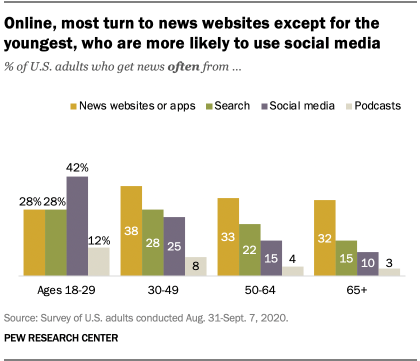The transition of news from print, television and radio to digital spaces has caused huge disruptions in the traditional news industry, especially the print news industry. It is also reflected in the ways individual Americans say they are getting their news. A large majority of Americans get news at least sometimes from digital devices, according to a Pew Research Center survey conducted Aug. 31-Sept. 7, 2020.
More than eight-in-ten U.S. adults (86%) say they get news from a smartphone, computer or tablet “often” or “sometimes,” including 60% who say they do so often. This is higher than the portion who get news from television, though 68% get news from TV at least sometimes and 40% do so often. Americans turn to radio and print publications for news far less frequently, with half saying they turn to radio at least sometimes (16% do so often) and about a third (32%) saying the same of print (10% get news from print publications often).
When asked which of these platforms they prefer to get news on, roughly half (52%) of Americans say they prefer a digital platform – whether it is a news website (26%), search (12%), social media (11%) or podcasts (3%). About a third say they prefer television (35%), and just 7% and 5% respectively say they prefer to get their news on the radio or via print.
Though digital devices are by far the most common way Americans access their news, where they get that news on their devices is divided among a number of different pathways. About two-thirds of U.S. adults say they get news at least sometimes from news websites or apps (68%) or search engines, like Google (65%). About half (53%) say they get news from social media, and a much smaller portion say they get news at least sometimes from podcasts (22%).
Among digital platforms, the most preferred one for news is news websites or apps: About a quarter of U.S. adults (26%) prefer to get their news this way, compared with 12% who prefer search, 11% who prefer to get their news on social media and 3% who say they prefer podcasts.
Younger Americans vary widely from their elders in news consumption habits
Underneath these numbers lie stark differences by age, with those under 50 showing very different news use patterns than their elders. Americans ages 50 and older use both television and digital devices for news at high rates, while the younger age groups have almost fully turned to digital devices as a platform to access news.

About half or more of adults 50 and older are still turning to TV for news often – 54% of those 50 to 64 and about two-thirds (68%) of those 65 and older. But among those ages 30 to 49, just a quarter say they get news on TV often, and just 16% say the same among those 18 to 29. For those age groups, digital devices are the dominant choice for news, with 67% of those 30 to 49 and 71% of those 18 to 29 getting news from a digital device often.
Among those 50 and older, differences between digital and non-digital news sources are less pronounced. Among adults 50 and older, 64% get news at least sometimes from both television and digital devices.

Within digital platforms for news, most age groups turn to news websites at higher rates than other platforms, with one exception. Americans ages 18 to 29 stand out in that the most common digital way they get news is social media, with 42% saying they get news this way often versus 28% saying the same of either news websites or search engines.

0 Comments